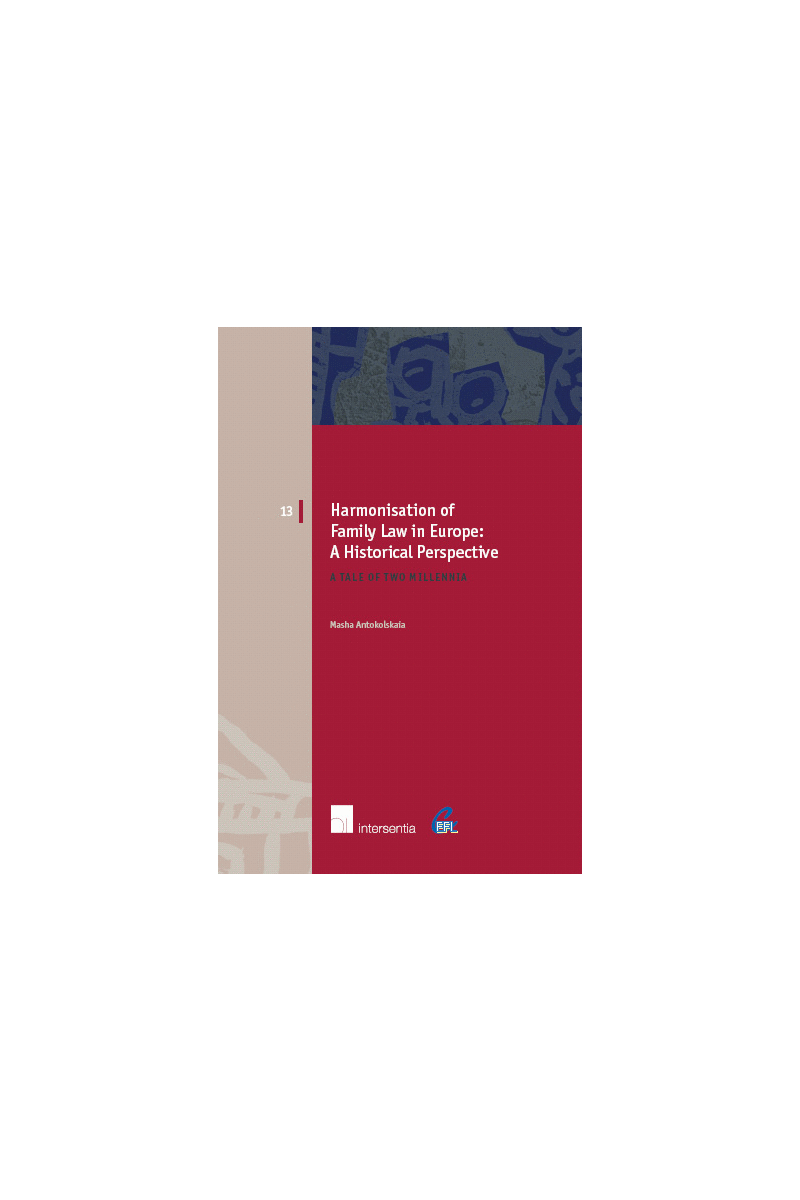 maestro
mastercard
visa
maestro
mastercard
visa

Harmonisation of Family Law in Europe: A Historical Perspective
A tale of two millennia

This book provides an overview of the developments in family law in Europe during the last two millennia. It aims to examine the so-called 'cultural constraints argument', which suggests that family law is unsuitable for harmonisation because the family laws of the European countries are deeply imbedded in their unique national cultures and history. It follows the path of the greatest-ever harmonisation event in European legal history: the creation of the medieval canon family law, and shows how, under the impact of pan-European economic, cultural and ideological trends, medieval uniformity turned into present-day diversity. Everywhere in Europe the evolution of family law generally followed the same pattern - from a traditional restrictive family law, built upon communitarian, transpersonal premises, to a more permissive family law, based upon modern personalistic ideology - yet national differences seem not to be disappearing. It appears, however, that this has little to do with the embedment of family law in unique national cultures and history. It is the differences in the balance of political power between the proponents and the opponents of the ongoing modernisation of family law that make the various countries respond to the pan-European challenges in dissimilar ways.
About this book
‘[...] this masterful work [...] will be of immense interest to many family lawyers in Europe.’
Brian Sloan in Rabels Zeitschrift 74 (2010)
| Type of product | Book |
|---|---|
| Format | Paperback |
| EAN / ISSN | 9789050955768 |
| Series name | European Family Law |
| Weight | 930 g |
| Status | Available |
| Number of pages | xxvii + 566 p. |
| Access to exercice | No |
| Publisher | Intersentia |
| Language | English |
| Publication Date | Nov 27, 2006 |
| Available on Strada Belgique | No |
| Available on Strada Europe | No |
| Available on Strada Luxembourg | No |
Downloads
- Table of Contents
- PART I. INTRODUCTION
- CHAPTER 1. INTRODUCTION
- CHAPTER 2. THE CULTURAL CONSTRAINTS ARGUMENT, CONVERGENCE, AND HARMONISATION: THEORETICAL ASPECTS
- PART II. FROM DIVERSITY TO UNIFORMITY: MEDIEVAL CANON LAW – THE IUS COMMUNE OF FAMILY LAW
- INTRODUCTION TO PART II
- CHAPTER 3. HISTORICAL PRECURSORS OF THE MEDIEVAL UNIFORM FAMILY LAW
- CHAPTER 4. FORMATION OF THE MEDIEVAL CANON IUS COMMUNE OF FAMILY LAW
- CHAPTER 5. MATRIMONIAL PROPERTY LAW IN THE HIGH MIDDLE AGES: BEYOND THE CANON LAW UNIFICATION
- CHAPTER 6. MEDIVAL CANON IUS COMMUNE OF FAMILY LAW: CONTINUANCE AND RADICAL CHANGE
- CHAPTER 7. THE MEDIEVAL IUS COMMUNE OF FAMILY LAW AND THE CURRENT HARMONISATION DEBATE
- PART III. MODERN TIMES – FROM UNIFORMITY TO THE CURRENT DIVERSITY. Similar developments: difference in timing, resemblance in substance
- INTRODUCTION TO PART III
- CHAPTER 8. DEVELOPMENT OF FAMILY LAW IN THE TIMES OF THE PROTESTANT REFORMATION
- CHAPTER 9. THE ENLIGHTENMENT: THE CRADLE OF THE MODERN IDEAS ON MARRIAGE AND THE FAMILY
- CHAPTER 10. THE NINETEENTH CENTURY: FAMILY LAW IN THE MIDDLE OF THE CONSERVATIVE-PROGRESSIVE DISCORD
- CHAPTER 11. THE TWENTIETH CENTURY UNTIL THE SIXTIES
- PART IV. CURRENT FAMILY LAW: SWEEPING MODERNISATION. Breakthrough of uniformity or self-reproducing diversity?
- CHAPTER 12. THE BACKGROUND OF THE REFORMS
- CHAPTER 13. ‘DEATH OF MARRIAGE’ OR SEARCH FOR A NEW CONCEPT OF MARRIAGE?
- CHAPTER 14. DIVORCE: HAS THE NO-FAULT REVOLUTION BROUGHT CONVERGENCE CLOSER?
- CHAPTER 15. NON-MARITAL COHABITATION: FROM OUTLAW TO FUNCTIONAL ALTERNATIVE FOR MARRIAGE
- CHAPTER 16. ILLEGITIMATE CHILDREN: FROM DISCRIMINATION TO EQUALITY AN EXAMPLE OF SUCCESSFUL HARMONISATION
- CHAPTER 17. MATRIMONIAL PROPERTY LAW
- PART V. CONCLUSION
- CHAPTER 18. CONCLUSION
- APPENDICES
- BIBLIOGRAPHY
- TABLE OF CASES